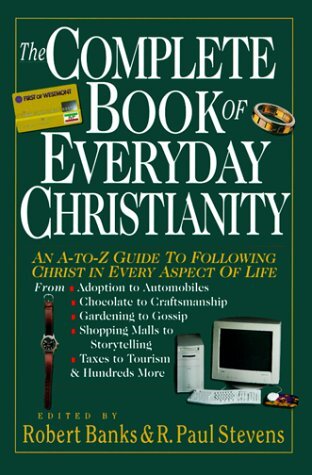Community
Book / Produced by partner of TOW
The word community is on many people’s lips today and is used in many different ways. It can, for example, refer to
any grouping of people, small or large, that springs out of organic, rather than organized, links (for example, a group of friends or people who regularly enjoy vacations together)
a cluster of people who are in some kind of kinship relation with one another (such as an extended family or clan)
a group of people in a locality who over time have formed some common bonds, interests or concerns (for example, a rural community or town)
an intensive, emotional shared experience between a group of people (such as a camping community or encounter group)
a longer-term, face-to-face gathering of people seeking to develop mutual bonds and obligations (such as a small group or house church; see Church in the Home)
a group of people who live together and have a common mission (for example, a religious order or community house)
a larger body of people who meet regularly and engage in common artistic, intellectual or religious activities (such as a synagogue or local church)
This wide range of meanings reminds us that we always need to be clear on how we or others are using the term. Here I shall focus on the first meaning, which has the longest history among thinkers about community, and the last meaning, which has the longest continuing usage in the church. A major article on church takes the view that community is the basic purpose of the church. The remaining meanings of the word listed above can be explored elsewhere in this volume.
Understanding Human Groupings
Over a century ago the German sociologist Ferdinand Toennies published his groundbreaking Community and Society (1887). He was building on a distinction, which had a long history in both Western and Eastern philosophy, between the kinds of groups to which people belong. In some cases there are natural links, forged through belonging to the same family or living in the same place, where people simply share a common life. In other cases they are rational, creating through joining an enterprise or club, where people are pursuing a particular purpose. The first type of relationship, a community, is an end in itself, even if other things spring out of it. The second, an association or society, is a means to some other end: it is task-oriented rather than existing for its own sake.
Other thinkers have similarly distinguished between mechanistic and organic (Émile Durkheim), familistic and contractual (Pitirim Sorokin), primary and secondary (C. H.Cooley) groups. Both kinds of groups exist in every society. But a dramatic shift occurred in the West after the Industrial Revolution, when more natural communities were broken up or weakened in favor of more planned ones. While this introduced more possibilities for achieving certain purposes, it came at the loss of close links that bound people together. This is why so many people lament the loss of community today and look back nostalgically to earlier times or rural settings when it was experienced more fully.
Community includes the home, craft guilds and the church, though over the course of time each has tended to take on board more elements of an association. For example, for many people marriage has become a contractual arrangement that can be easily broken if certain goals are not met; the workplace has become governed by contracts and regulations rather than by family links or vocational commitment; and the church in places is becoming a kind of corporation, emphasizing programs rather than the body of Christ experiencing fellowship. The communal element in family, work and church life has been further diminished through the intrusion of bureaucratic procedures and regulations.
Misunderstanding Christian Community
The distinction between community and association is also useful in differentiating between various kinds of Christian groups. It helps us understand the well-known distinction drawn between modalities (congregations) and sodalities (mission groups), between the local church and parachurch organizations, and between support groups and mission.
Failure to recognize the many differences between a community and an association has led many Christian enterprises to become confused as to their own purpose or to misunderstand what other groups are doing. Some examples of this follow:
When something organic such as the formation of communal groups or small groups in the church is approached in too organized, contrived or programmed a way, the experience of community is undercut rather than enhanced.
When the decision-making processes and leadership of a task-oriented enterprise are too dependent on everyone’s participation and feeling good about the outcome, inefficient management of the organization results.
When congregations and parachurch organizations remain suspicious of one another or trespass on the limits proper to each, they generally fail to see that one is primarily about nurture for its members and outreach to its immediate community and the other primarily about mission to a diffused constituency, with the nurturing element only to that end.
When the leaders of a program, say in Christian education, do not see that it must be both people- and task-directed, forming people spiritually and relationally as well as enhancing learning and practice, they fail to understand which category particular activities fall into and end up confusing the two.
In all these ways the distinction between community and association helps us to understand what community is and is not about. Its meaning is deepened when we see community as an expression of the communal life of our trinitarian God. We are called upon to express to God and one another the same unconditional faithfulness, self-sacrificing love and visionary hope we find in Christ. None of this is possible without the presence, gifting and fruit of the Spirit. The articles indicated by asterisks above indicate the ways in which Christians are to express and develop community.
» See also: Church
» See also: Church in the Home
» See also: Church, Small
» See also: Church Structures
» See also: Clubs
» See also: Community, Rural
» See also: Fellowship
» See also: Neighborhood
» See also: Networking
» See also: Small Groups
» See also: Society
References and Resources
P. M. Cooey, Family, Freedom and Faith: Building Community Today (Louisville, Ky.: Westminster John Knox, 1996); R. A. Nisbet, The Quest for Community (New York: Oxford University Press, 1953); G. Tinder, Community: Reflections on a Tragic Ideal (Baton Rouge: Louisiana State University Press, 1980); F. Toennies, Community and Society (New York: Harper & Row, 1957).
—Robert Banks





